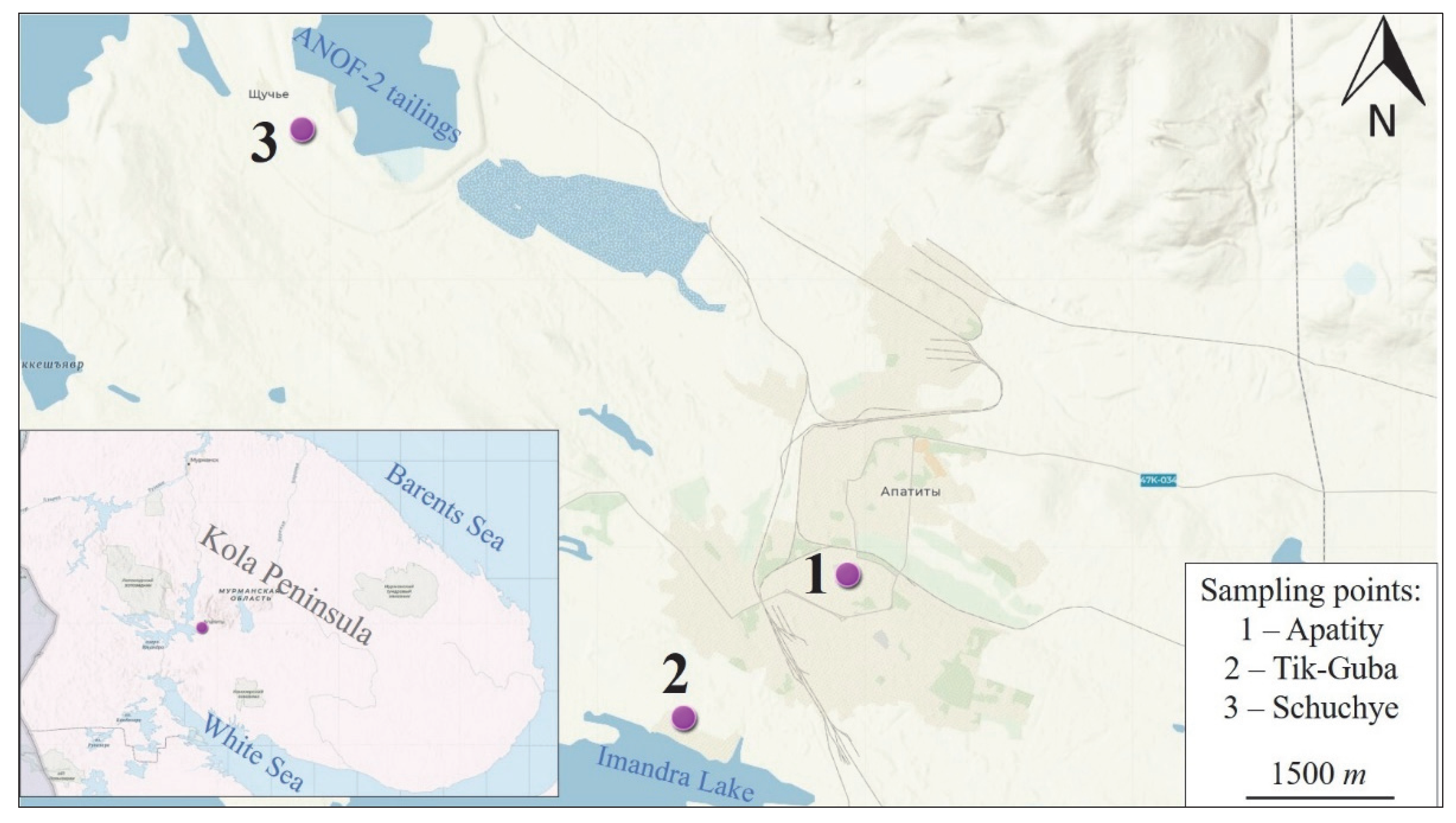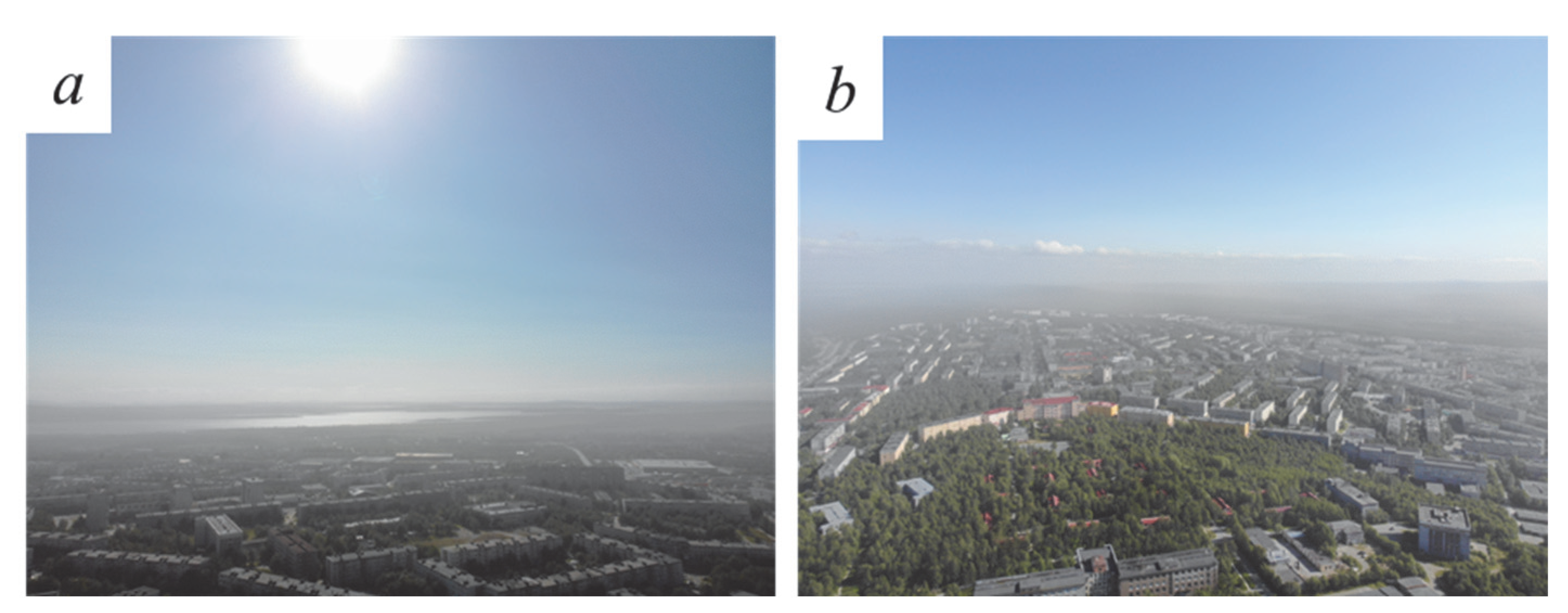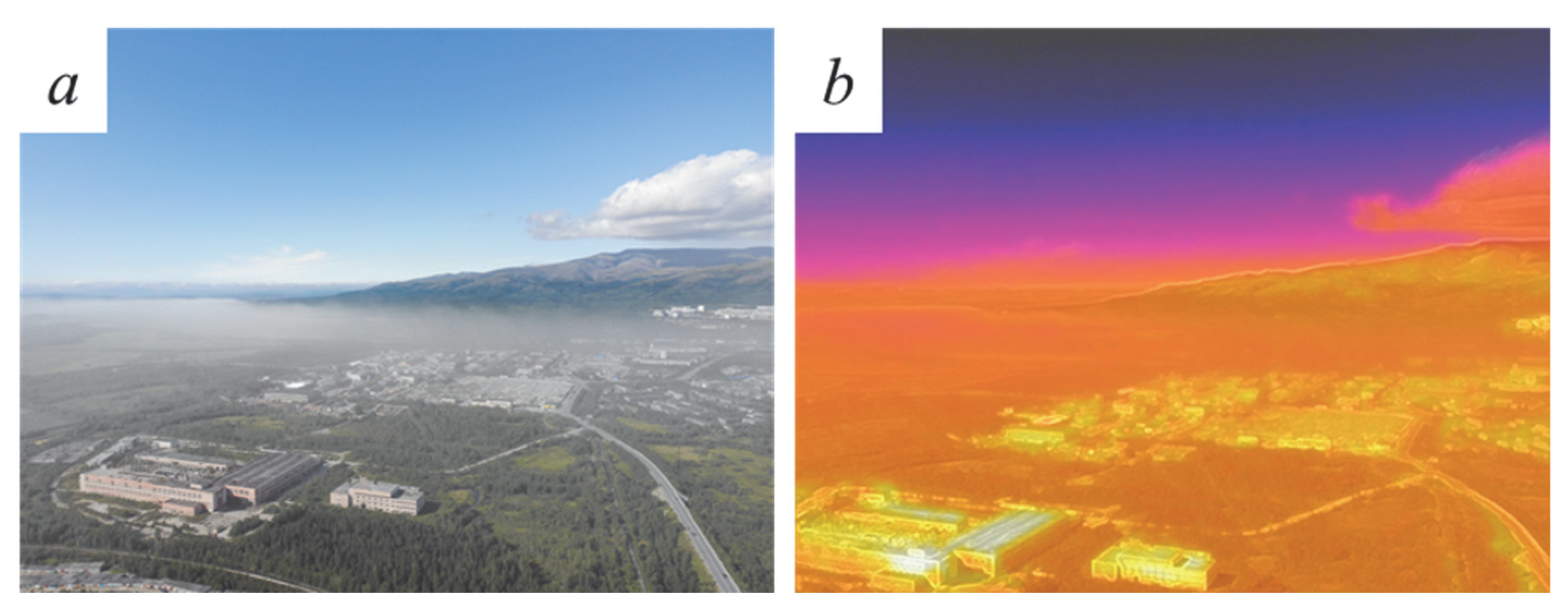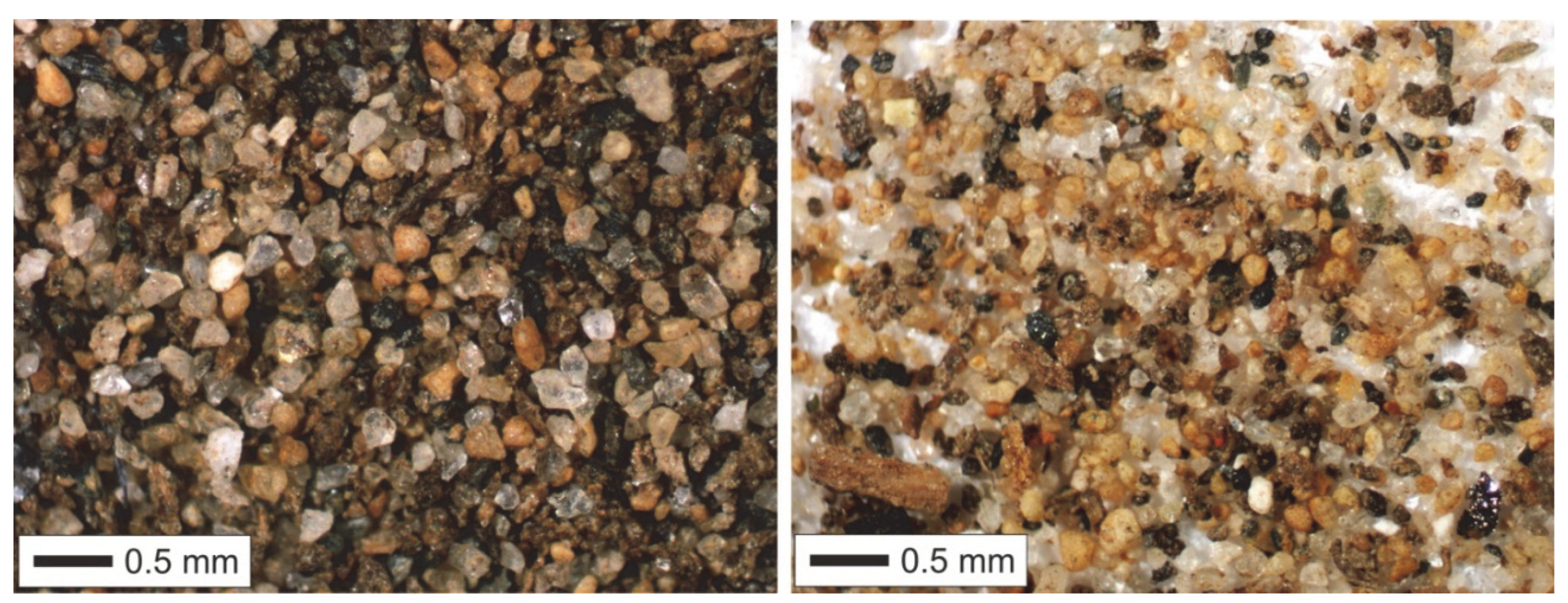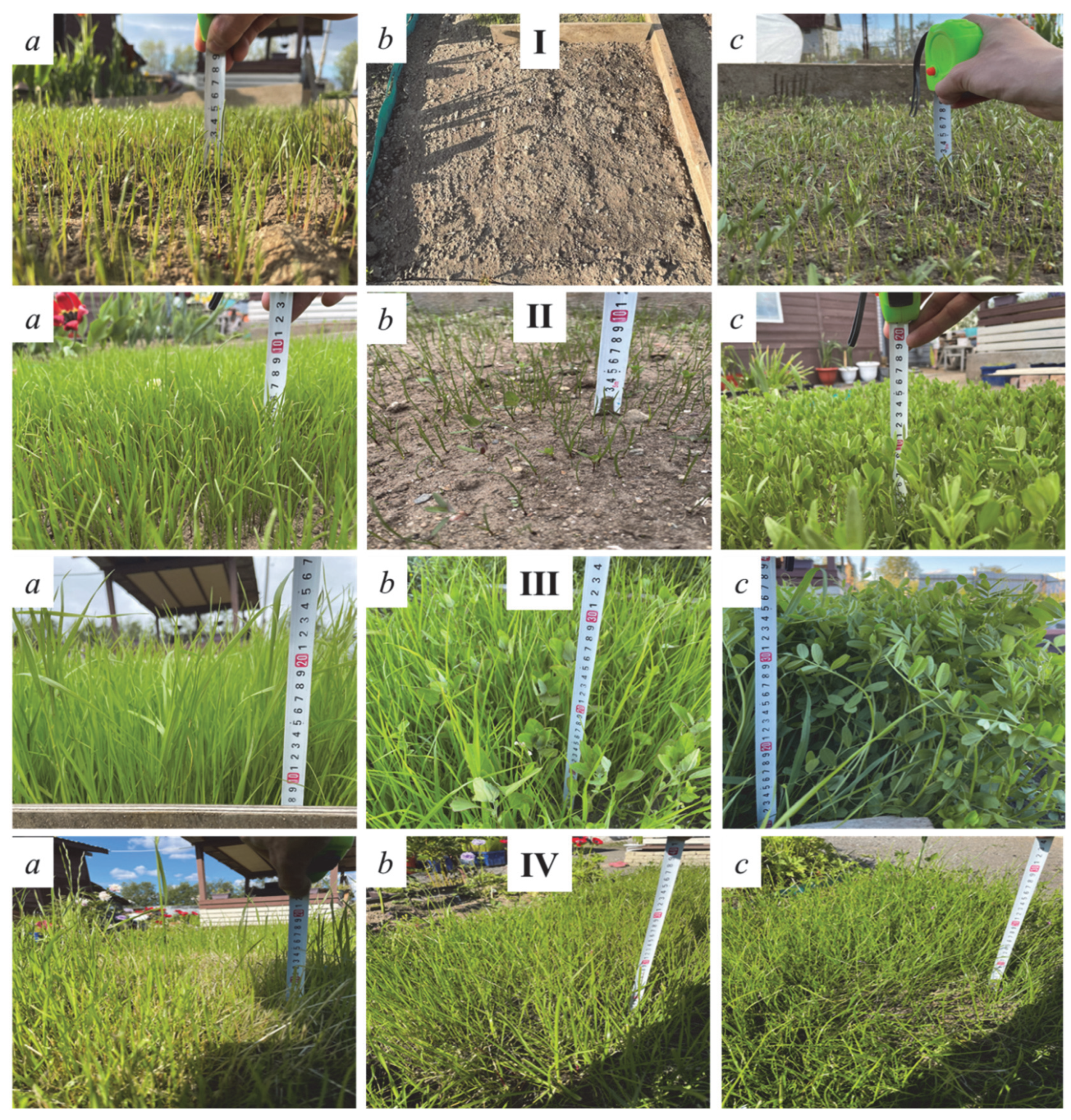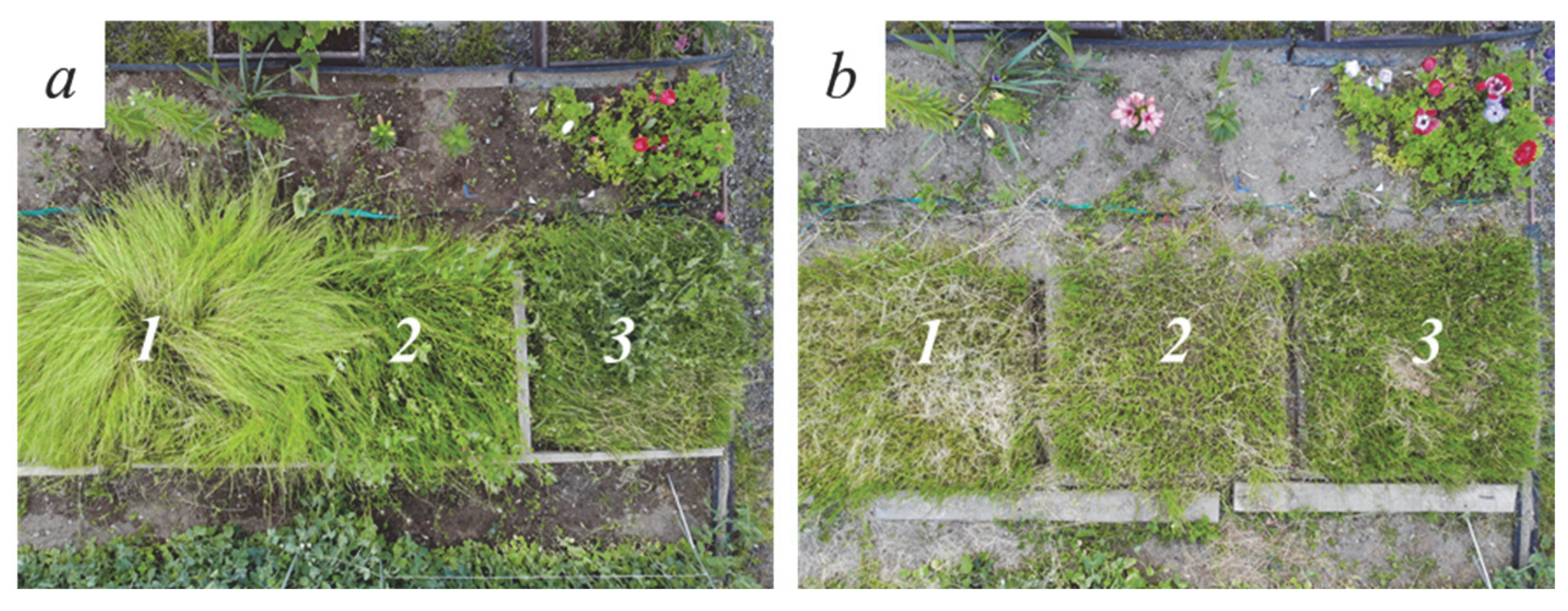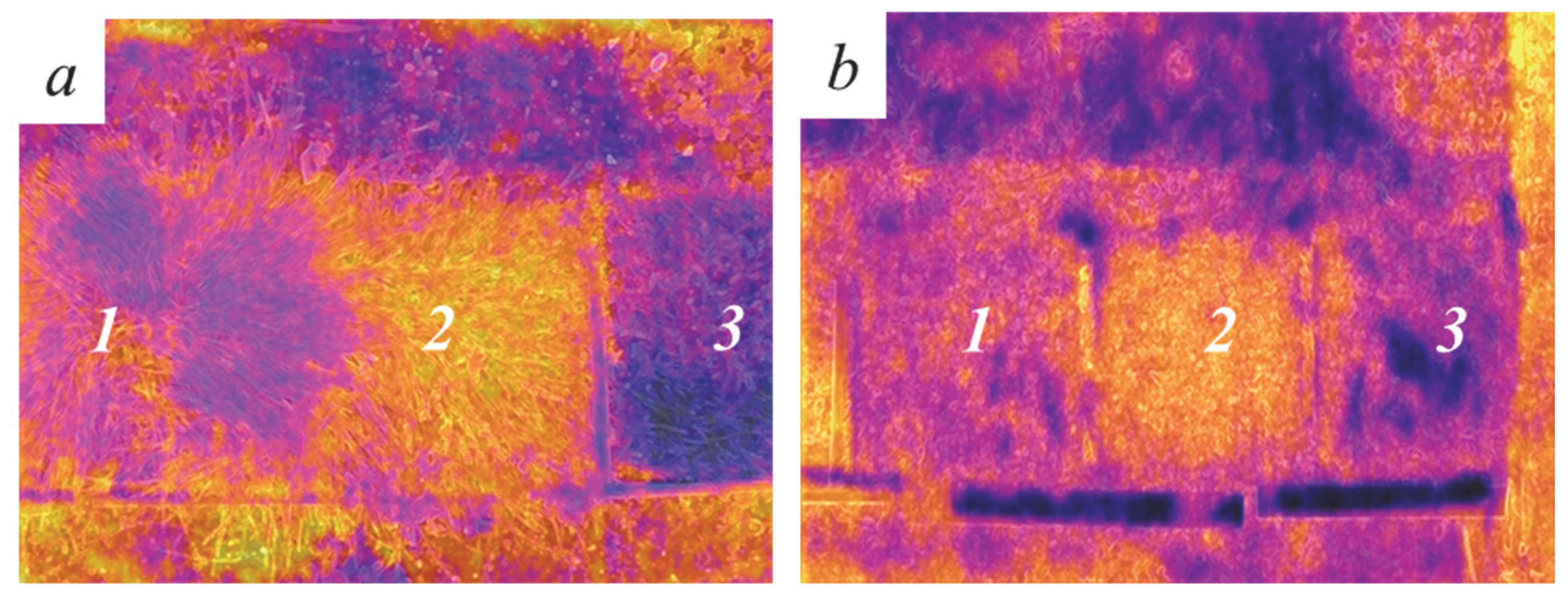1. Introduction
The national environmental policy of the Russian Federation is based on the recommendations of the UN Conference on Environment and Development (Rio de Janeiro, 1992) and subsequent global conferences on the environment and sustainable development. Sustainable development of the country, high quality of life, and health of the residents can be achieved only if natural systems are preserved, and the appropriate quality of the environment is maintained. One of the conditions for achieving sustainable development goals is to build a comfortable urban environment, where a significant role should be played by green areas [
1].
The lawn is the background and the landscaping element supporting ornamental plants, architectural structures, and other elements of garden and park design, as well as utility, cultural, and industrial objects and facilities. The environmental role of the lawn is to increase the production of oxygen and phytoncides inhibiting the development of pathogenic microflora. One hectare of grass produces the same amount of oxygen (5–19 tons per year) and phytoncides as one hectare of forest, and protects the soil from wind and water erosion [
2]. An important property of tall grass is its ability to reduce the speed of wind by up to 10% [
3].
In the urban areas of Russia’s Murmansk region, green spaces are constantly exposed to various types of anthropogenic impacts, which, combined with the prevailing climate, often become the main reason for their unsatisfactory condition. Soils of residential, industrial, logistics, and public utility sites are characterized by an elevated level of pollutants, especially heavy metals [
4]. The erosion of these soils leads both to the migration of pollutants in the form of fine dust into the neighboring ecosystems, and to an increase in the reclamation costs associated with eroded landscape areas, embankments, slopes, hydraulic structures, and road surfaces. In addition, as a result of the long-term intensive mining and mineral processing operations in the Murmansk region, a significant amount of fine-grained concentration tailings has accumulated. The surface of the tailings is often a source of increased emission of dust particles into the atmospheric air, causing a negative impact on the ecosystems and public health. One of the two existing tailings storage facilities (TSF) at Apatit JSC, Kirovsk is intended for storing the tailings produced by the operation’s apatite–nepheline Plant 2 (ANOF-2). ANOF-2 TSF is located in the Belaya Bay of Lake Imandra at a distance of approximately 3 km from the nearest residential areas. The tailings storage facility is the largest in the Murmansk region and occupies 1650 hectares. Drying of the tailings surface results in a quick loss of moisture in the top layers, while wind causes dusting, leading to a deterioration of the public health situation in the city of Apatity [
5].
A significant number of works have been devoted to the negative impact of anthropogenic activities on vegetation, as well as the role of green spaces in the urban environment, with special attention paid to the impact of dust particles on the urban green areas [
6,
7,
8,
9,
10,
11,
12,
13,
14,
15,
16]. The authors of [
17] conducted a study of the content of dust particles, (PM
2.5) and (PM
10), in green areas. They found that the content of dust particles in the atmospheric air is dependents on weather conditions and the structure of vegetation. Some authors focused on the development of green areas under the influence of anthropogenic load, and offered solutions for greening urban areas [
18,
19,
20,
21,
22].
However, the problem of preserving and maintaining the sustainable functioning of urban lawns is especially relevant for Arctic cities, where ecosystems are fragile and have low resistance to external anthropogenic impacts. The purpose of this study was to examine the development dynamics of various lawn grass species in the city of Apatity, Murmansk region, when exposed to anthropogenic and atmospheric pollution impacts.
2. Materials and Methods
In city of Apatity, during the summer–autumn season of 2021, the concentration of dust particles in the atmospheric air, the composition of the dust, and the development of lawn grass when exposed to anthropogenic impacts were observed. The study area has a moderately maritime climate, which is not typical for the region as a whole, since the Khibiny Mountains act as a natural obstacle to air flow. The average annual temperature ranges between +3.1 and −2.8 °C, and the lowest average monthly temperature is observed in February at −12.2 °C. The highest average monthly temperature is observed in July at +13.5 °C. The average duration of the growing season is 106 days. Seventy percent of the 485 mm average annual precipitation falls between April and October [
23]. The bedrocks of the Khibiny massif are khibinites, and the main rock-forming mineral is nepheline (NaAlSiO₄). The acidity of the Khibiny soils is low, which is associated with the weathering of nepheline syenites [
24]. The profiles of urban soils correspond to natural ones, except for the absence of the upper horizon, which is replaced by a newly formed anthropogenic horizon, 5–30 cm thick, consisting of mixed material formed from the upper horizons of the original soils and inclusions of artifacts (construction and household waste) [
25].
Measurement of the total dust load in the air was carried out using the gravimetric method, based on passing dusty air through a dust filter and then measuring the mass of the trapped dust. Dust particles were collected using an AVA-1 aspirator (by NIKI MLT LLC, St. Petersburg, Russia). The studied air was passed through an analytical aerosol filter (AFA-VP-20, by Novolab LLC, Novosibirsk, Russia), which was weighed before and after sampling. The measurement was carried out five times a week from July 1, 2021 to September 30, 2021. Sampling was carried out over 15 min, and the air flow during the measurement was 1.5 m
3. The filters were weighed on a Sartogosm MV 210-A analytical balance (by Sartogosm LLC, St. Petersburg, Russia). Sampling layout is shown in
Figure 1.
Minerals were examined and identified visually using a Carl Zeiss Stemi 2000 stereomicroscope (by Carl Zeiss Microscopy GmbH, Oberkochen, Germany) based on the physical properties of the minerals (color, gloss, transparency, cleavage, fracture, hardness, and morphology). Raman spectroscopy was used as an auxiliary method using an EnSpectr R532 spectrometer (by Spektr-M LLC, RAS Institute of Solid State Physics, Chernogolovka, Russia) based on an Olympus BX43 optical microscope (by Olympus Corp., Tokyo, Japan).
During the specified sampling period, a study was undertaken of the development of the lawns under the climatic conditions of Apatity, as well as the impact of undifferentiated dust in the atmospheric air. Three lawn grass types of different composition were selected for the study. The first sample (Sample 1) was composed of perennial ricegrass (
Lolium perenne L.)—45%, meadow fescue (
Festuca pratensis Huds.)—25%, red fescue (
Festuca rubra subsp.
rubra)—15%, and red fescue (
Festuca rubra subsp.
commutata)—10%, meadow bluegrass (
Poa pratensis L.)—5%. The second sample (Sample 2) was composed of red fescue (
Festuca rubra subsp.
rubra)—60%, meadow bluegrass (
Poa pratensis L.)—15%, red fescue (
Festuca rubra L.)—15%, and red fescue (
Festuca rubra subsp.
commutata)—10%. The third sample (Sample 3) was composed of spring vetch (
Vicia sativa L.)—55%, perennial ricegrass (
Lolium perenne L.)—20%, meadow fescue (
Festuca pratensis Huds.)—20%, and red clover (
Trifolium repens L.)—5%. The location of the lawns in
Figure 1 shows site 2 in the village of Tik-Guba.
Lawn growth and atmospheric air condition were studied using images obtained using an unmanned aerial vehicle, DJI Mavic 2 Enterprise Dual (by SZ DJI Technology Co., Ltd., China). The experimental results were processed using statistical methods in Microsoft Excel.
3. Results and Discussion
3.1. Mineral Dust Concentration in the Atmospheric Air
Our study of the concentration of dust in the atmospheric air showed that the applicable MPC
m.o., which is 50 mg/m
3, was exceeded only in July (
Figure 2a). The average dust concentration in July at sampling points 1 and 2 was the same and amounted to 0.20 mg/m
3, while the average July concentration at sampling point 3 was 0.30 mg/m
3. MPC at sampling point 3 was exceeded four times, with the maximum observed on 28 July, when the concentration of dust in the air reached 0.59 mg/m
3. On that day, high dust levels were observed at all sampling points. At sampling point 1, the dust concentration was 0.58 mg/m
3. At sampling point 2, the dust concentration was 0.45 mg/m
3, which is close to MPC
m.o. These high concentrations of dust at all sampling points on the indicated date were obviously associated with the dusting of the ANOF-2 tailings (
Figure 3 and
Figure 4). Dusting from the surface of the tailings on that specific day was due to gusty winds, where the wind speed reached 5 m/s. In addition, the moisture content in the surface layer of some of the TSF areas was lower than usual due to several days without precipitation.
Figure 3 illustrates the condition of atmospheric air in Apatity on July 28. The atmosphere is visually characterized by high dust content, covering both the city and beyond.
Figure 4 shows dusting from the ANOF-2 TSF. The consequences of prolonged presence of high concentration of dust particles in the atmospheric air can be negative. Dust from the surface of the ANOF-2 TSF entering the atmospheric air can significantly affect the amount of incoming solar radiation if it stays in the air long enough. This is supported by
Figure 4b, where the area of low emissivity due to airborne dust can be seen to experience less heating compared to other objects.
During the rest of the study period, no significant dusting was observed. Throughout August, dust concentrations at the sampling points never exceeded the MPC
m.o. values. Average concentrations at sampling points 1, 2, and 3 were 0.19, 0.15, and 0.23 mg/m
3. Sampling point 1 is characterized by periodic increases in the concentration of dust up to 0.30 mg/m
3, while the curve at sampling point 2 is flatter (
Figure 2b). This is probably due to the intensity of city traffic, which contributes to a sharp short-term increase in the dust concentrations at sampling point 1, while sampling point 2 is located at a considerable distance from the city center and is less affected by heavy traffic. In September, the average dust concentrations at all sampling points decreased to 0.12, 0.13, and 0.17 mg/m
3, respectively. Some increase in the dust concentration was noted on September 23, which was associated with high wind speed, with gusts reaching 10 m/s (
Figure 2c).
During the study period, several cases of intense dusting were observed when the MPCm.o. values were exceeded. The dust impact is the strongest in the summer months, which is associated with heavy traffic and dusting from the surface of fine-grained concentration tailings. Dusting from the tailings surface usually occurs several times during the summer months and leads to an increase in the concentration of mineral dust particles in the air, becoming a potential threat to the health of the residents of Apatity. During the summer, urban vegetation, in addition to the negative impact factors inherent in the city, is exposed to high concentrations of mineral dust in the atmospheric air.
Given the periodic major increase in the concentration of dust particles in the atmospheric air, special attention should be paid to the establishment and maintenance of green areas. Under the conditions of climate change, it should be noted that an increase in average seasonal temperatures, as well as the duration of a snow-free and frost-free period, should contribute to an increase in the negative environmental impact of tailings.
3.2. Mineralogical Composition of Dust
Previous studies have shown that the tailings of the surface layer are characterized by the predominance of fractions with a grain size of −0.5 + 0.25 mm and −0.25 + 0.1 mm, which in total account for 70–80% of the mass of the tails. The predominant mineral of the tailings is nepheline, which exceeds 50% of the content. The tailings also contain aegirine, feldspars, secondary minerals for nepheline, apatite, titanite, magnetite, and micas [
26].
The main minerals in the dust sample were quartz and feldspars. Quartz is transparent, partially rounded, hard, and shows no cleavage. Intergrowth with hematite, green pyroxenes or chlorite, and feldspars is occasionally observed (
Figure 5). Feldspars are most often opaque, partially rounded, with cleavage observed.
The following was also found in the sample:
Fragments of elongated, dark green crystals with clear cleavage—pyroxene of the aegirine–augite series;
Single finds of rounded intergrowths of cloudy-greenish nepheline with pyroxene;
Exfoliating flakes of various micas—transparent, almost colorless muscovite, brown phlogopite, and black biotite;
Single fine grains of natrolite, apatite, rinkite, epidote, amphibole, garnet, chalcopyrite, etc.
Thus, in the samples of atmospheric dust, minerals were found that are typical for the tailings of the enrichment of apatite–nepheline ores. This indicates a high migration ability of mineral dust raised from the surface of the ANOF-2 tailing dump.
Figure 6 shows the Raman spectra of reference nepheline (
Figure 6a) and nepheline found in dust samples (
Figure 6b). Nepheline particles are largely rounded. This is due to the fact that at the stage of hydrotransport and pulp discharge into tailings, fine particles of nepheline interact with large particles of other minerals.
3.3. Lawn Growth under Anthropogenic Load
In our study of lawn grass development, the samples had different germination rates.
Figure 7 shows images taken at various intervals of time after planting. In samples 1 and 3, the first shoots were observed 7 days after sowing, while sample 2 failed to produce shoots. This is due to the predominance of perennial ricegrass (
Lolium perenne L.) in the composition of lawn grass samples 1 and 3. Ricegrass is characterized by intensive development in the first year of life but is not perennial. This species is recommended when there is a need to accelerate the establishment of temporary lawns. A total of 25 days after sowing, sample 2 began to give rare shoots, while samples 1 and 3 demonstrated a significant height and density of grass cover.
In the following days, all three turf grass samples gained biomass at the same rate. Given that the rate of height growth in sample 2 throughout the entire period of the study was lower compared to the other samples, this type of lawn is advisable to choose where frequent mowing is not feasible. That said, the lawn grass in sample 2 was seemingly unaffected by the quality of the soil and lighting conditions, and withstood significant temperature variations. The fraction of meadow bluegrass (Poa pratensis L.) in sample 2 is 15%, which makes the lawn grass suitable for sowing in urban areas, since bluegrass is resistant to trampling.
Samples 1 and 2 were characterized by low weed growth throughout the entire study period. This is due to a significant fraction of red fescue in the lawn grass. This species has a strong ability to suppress weeds in the herbage. It was established that this grass species, despite the anthropogenic impact and challenging climatic conditions, had satisfactory growth rates and formed a good quality lawn. After passing a predetermined height, all three samples were mowed.
Figure 8b shows the appearance of the lawns after mowing.
Figure 9 shows infrared images of the samples. The images indicate different surface temperatures, as the studied lawn grass types have different reflectivity. For instance, sample 2 warms up much better when exposed to solar radiation and retains heat. These features should be taken into account when designing urban landscapes in the Arctic where daylight hours are long in the summer months. The predominance in the composition of sample 3 of common vetch (
Vicia sativa L.) caused its lower temperature, which is associated with high emissivity and heat transfer in the evening, when the intensity of the incoming solar radiation decreases.
Thus, in addition to the previous work showing the results of the successful use of lawn grasses for urban greening, it has been found that in areas of intense mining impact, the use of lawn grasses is also applicable for landscape design. The results obtained showed the ability of lawn grasses to grow when exposed to atmospheric dust of a specific mineral composition.
4. Conclusions
In this study, several cases of airborne dust concentrations exceeding the MPCm.o. were recorded. High dust concentrations were caused by both heavy traffic within the city and dusting from the surface of the ANOF-2 TSF.
Nepheline particles were found in the mineral dust samples, which indicates potential migration within a considerable distance from the surface of the tailing storage facility. Thus, the urban areas studied are exposed to strong anthropogenic impacts, which leads to the need to find ways to partially restore the natural potential of the territory.
Our study showed that, despite the challenging climate, urban landscaping in the Arctic using lawns is feasible. Lawns should be established using mainly perennial grasses capable of developing a strong turf which is able to withstand mechanical damage and other adverse factors. Well-known and widely used lawn grass species, such as red fescue and meadow grass, with narrow dark green basal leaves, are quite resistant to frequent mowing and human traffic.
Lawns are able to develop even when exposed to strong industrial impacts, as illustrated by the example of the city of Apatity. Establishing a lawn is an effective way to reduce air pollution, cover bare earth surfaces, and prevent dusting and erosion. Wind-blown dust inevitably settles on the surface of the stems and leaves of lawn grasses. Thus, lawns not only reduce the dust-producing area of an urban community, but also prevent the spread and transfer of dust from one place to another. As long as science-based lawn care practices are followed, native herbage can survive for 10 years or more.
Changing the approach to establishing and caring for sown lawns will help preserve and restore landscape and biological diversity in the industrially developed and urbanized areas of the Murmansk region. Specifying the optimal composition of lawn grass, adapted to the conditions prevailing in the Far North, will support the successful functioning of urban green areas and reduce the negative impact of industry on urban ecosystems. This is of particular practical interest for the entire Russian Arctic, the sustainable development of which is possible with the stable operation of mining and processing enterprises if fragile ecosystems are preserved.
Author Contributions
Conceptualization, A.G.; methodology, A.G.; software, A.K.; validation, T.M., D.M. and V.M.; formal analysis, A.K.; investigation, A.G., T.M., A.K. and D.M.; resources, D.M.; data curation, V.M.; writing—original draft preparation, A.G.; writing—review and editing, T.M., A.K., D.M. and V.M.; visualization, A.K.; supervision, D.M. and V.M.; project administration, D.M.; funding acquisition, V.M. All authors have read and agreed to the published version of the manuscript.
Funding
This research was funded by Russian government grant nos. 1021051803680-5 and 0226-2019-0011 and partially supported by the RFBR grant No. 19-05-50065 «Microcosm».
Institutional Review Board Statement
Not applicable.
Informed Consent Statement
Not applicable.
Data Availability Statement
All the data used in this study can be found from the published manuscript.
Conflicts of Interest
The authors declare no conflict of interest.
References
- Bukharina, I.L.; Dvoeglazova, A.A. Bioecological Features of Herbaceous and Woody Plants in Urban Green Spaces: Monograph; Editorial and Publishing Department «Udmurt University»: Izhevsk, Russia, 2010; Volume 184. (In Russian) [Google Scholar]
- Lukinykh, G.L.; Luganskaya, S.N. Morphobiological Characteristics of Perennial Grasses Used to Create Lawns in the Middle Urals Conditions; Editorial and Publishing Department Ural State Forest Engineering University: Yekaterinburg, Russia, 2010; Volume 36. (In Russian) [Google Scholar]
- Kurinskaya, L.V. Phytomeliorative role of lawns in urban environments. Strategy Sustain. Dev. Russ. Reg. 2012, 11, 141–143. (In Russian) [Google Scholar]
- Isaeva, L.G.; Sukhareva, T.A. Assessment of the green spaces state in the impact zone of the Pechenganickel smelter in the Murmansk region. Vestn. MSTU 2021, 24, 97–106. [Google Scholar]
- Makarov, D.V.; Svetlov, A.V.; Goryachev, A.A.; Konina, O.T.; Masloboev, V.A. Tailings dust emissions caused by the climate change: A case-study of a mine in Russia‘s far north. Min. Inf. Anal. Bull. (Sci. Tech. J.) 2021, 5, 122–133. (In Russian) [Google Scholar]
- Diener, A.; Mudu, P. How can vegetation protect us from air pollution? A critical review on green spaces’ mitigation abilities for air-borne particles from a public health perspective-with implications for urban planning. Sci. Total Environ. 2021, 796, 148605. [Google Scholar] [CrossRef]
- Bi, S.; Chen, M.; Dai, F. The impact of urban green space morphology on PM2.5 pollution in Wuhan, China: A novel multiscale spatiotemporal analytical framework. Build. Environ. 2022, 221, 109340. [Google Scholar] [CrossRef]
- Wang, Z.; Zhou, W.; Jiskani, I.M.; Luo, H.; Ao, Z.; Mvula, E.M. Annual dust pollution characteristics and its prevention and control for environmental protection in surface mines. Sci. Total Environ. 2022, 825, 153949. [Google Scholar] [CrossRef] [PubMed]
- Chaudhary, I.J.; Rathore, D. Dust pollution: Its removal and effect on foliage physiology of urban trees. Sustain. Cities Soc. 2019, 51, 101696. [Google Scholar] [CrossRef]
- Jaafari, S.; Shabani, A.A.; Moeinaddini, M.; Danehkar, A.; Sakieh, Y. Applying landscape metrics and structural equation modeling to predict the effect of urban green space on air pollution and respiratory mortality in Tehran. Environ. Monit. Assess. 2020, 192, 412. [Google Scholar] [CrossRef]
- Selmi, W.; Weber, C.; Rivière, E.; Blond, N.; Mehdi, L.; Nowak, D. Air pollution removal by trees in public green spaces in Strasbourg city, France. Urban For. Urban Green. 2017, 17, 192–201. [Google Scholar] [CrossRef]
- Shen, Y.S.; Lung, S.C.C. Mediation pathways and effects of green structures on respiratory mortality via reducing air pollution. Sci. Rep. 2017, 7, 42854. [Google Scholar] [CrossRef]
- Shan, Y.; Jingping, C.; Liping, C.; Zhemin, S.; Xiaodong, Z.; Dan, W.; Wenhua, W. Effects of vegetation status in urban green spaces on particle removal in a street canyon atmosphere. Acta Ecol. Sin. 2007, 27, 4590–4595. [Google Scholar] [CrossRef]
- Javanmard, Z.; Kouchaksaraei, M.T.; Hosseini, S.M.; Pandey, A.K. Assessment of anticipated performance index of some deciduous plant species under dust air pollution. Environ. Sci. Pollut. Res. 2020, 27, 38987–38994. [Google Scholar] [CrossRef] [PubMed]
- Meo, S.A.; Almutairi, F.J.; Abukhalaf, A.A.; Usmani, A.M. Effect of Green Space Environment on Air Pollutants PM2.5, PM10, CO, O3, and Incidence and Mortality of SARS-CoV-2 in Highly Green and Less-Green Countries. Int. J. Environ. Res. Public Health 2021, 18, 13151. [Google Scholar] [CrossRef] [PubMed]
- Bagheri, Z.; Nadoushan, M.A.; Abari, M.F. Evaluation of the effect of green space on air pollution dispersion using satellite images and landscape metric: A case study of Isfahan City. Fresenius Environ. Bull. 2017, 26, 8135–8145. [Google Scholar]
- Qiu, L.; Liu, F.; Zhang, X.; Gao, T. The reducing effect of green spaces with different vegetation structure on atmospheric particulate matter concentration in BaoJi City, China. Atmosphere 2018, 9, 332. [Google Scholar] [CrossRef]
- Yilmaz, S.; Sezen, I.; Sari, E.N. The relationships between ecological urbanization, green areas, and air pollution in Erzurum/Turkey. Environ. Ecol. Stat. 2021, 28, 733–759. [Google Scholar] [CrossRef]
- Gontar’OB, S.E.; Svyatkovskaya, E.A.; Trostenyuk, N.N.; Korobeynikova, N.M.; Shlapak, E.P.; Nosatenko, O.Y. Monitoring the state of tree plantations at some landscaping objects in the central part of the city of Murmansk. Izv. RAS SamSC 2013, 15, 621–625. (In Russian) [Google Scholar]
- Gontar’OB, S.E.; Svyatkovskaya, E.A.; Trostenyuk, N.N.; Zhirov, V.K. Stages of creation and analysis of the features of the assortment of ornamental woody plants for optimal landscaping of Kola North urbanized areas. Vestn. MSTU 2011, 14, 577–582. [Google Scholar]
- Gontar’OB, S.E.; Svyatkovskaya, E.A.; Trostenyuk, N.N.; Zhirov, V.K.; Saltan, N.V. Phytoncidal and fragrant woody plants in landscaping urban areas of the Kola North. Izv. RAS SamSC 2016, 18, 70–74. [Google Scholar]
- Lukinykh, G.L. Lawn as a way of the modern city sustainable environment creation in the Middle Ural. Bull. KrasGAU 2013, 12, 87–91. (In Russian) [Google Scholar]
- Isachenko, A.G. Ecological Geography of Northwestern Russia; Editorial and Publishing Department «SpB»: Saint Petersburg, Russia, 1995; Volume 1, p. 97. [Google Scholar]
- Kozarenko, A.E.; Semenov, V.A.; Koзapeнкo, A.E.; CeмeHoB, B.a. Features of the chemical composition of soils of the Khibiny and Lovozero massifs. Bull. Mosc. City Pedagog. Univ. Ser. Nat. Sci. 2016, 2, 62–72. (In Russian) [Google Scholar]
- Korneykova, M.V.; Nikitin, D.A.; Dolgikh, A.V.; Soshina, A.S. Soil mycobiota of the Apatity City (Murmansk region). Mikol. Fitopatol. 2020, 54, 264–277. [Google Scholar]
- Masloboev, V.A.; Svetlov, A.V.; Konina, O.T.; Mitrofanova, G.V.; Turtanov, A.V.; Makarov, D.V. Selection of binding agents for dust prevention at tailings ponds at apatite–nepheline ore processing plants. J. Min. Sci. 2018, 2, 161–171. [Google Scholar] [CrossRef]
| Publisher’s Note: MDPI stays neutral with regard to jurisdictional claims in published maps and institutional affiliations. |
© 2022 by the authors. Licensee MDPI, Basel, Switzerland. This article is an open access article distributed under the terms and conditions of the Creative Commons Attribution (CC BY) license (https://creativecommons.org/licenses/by/4.0/).
